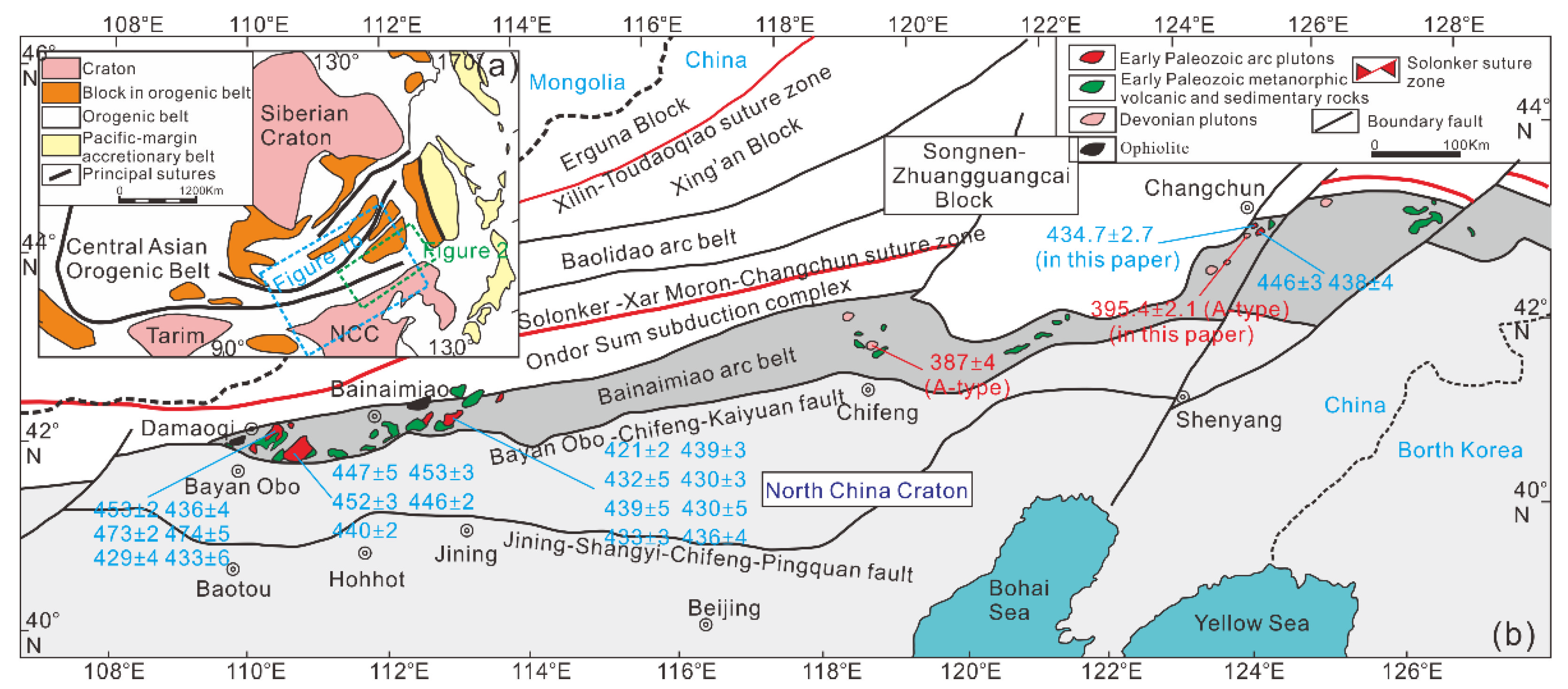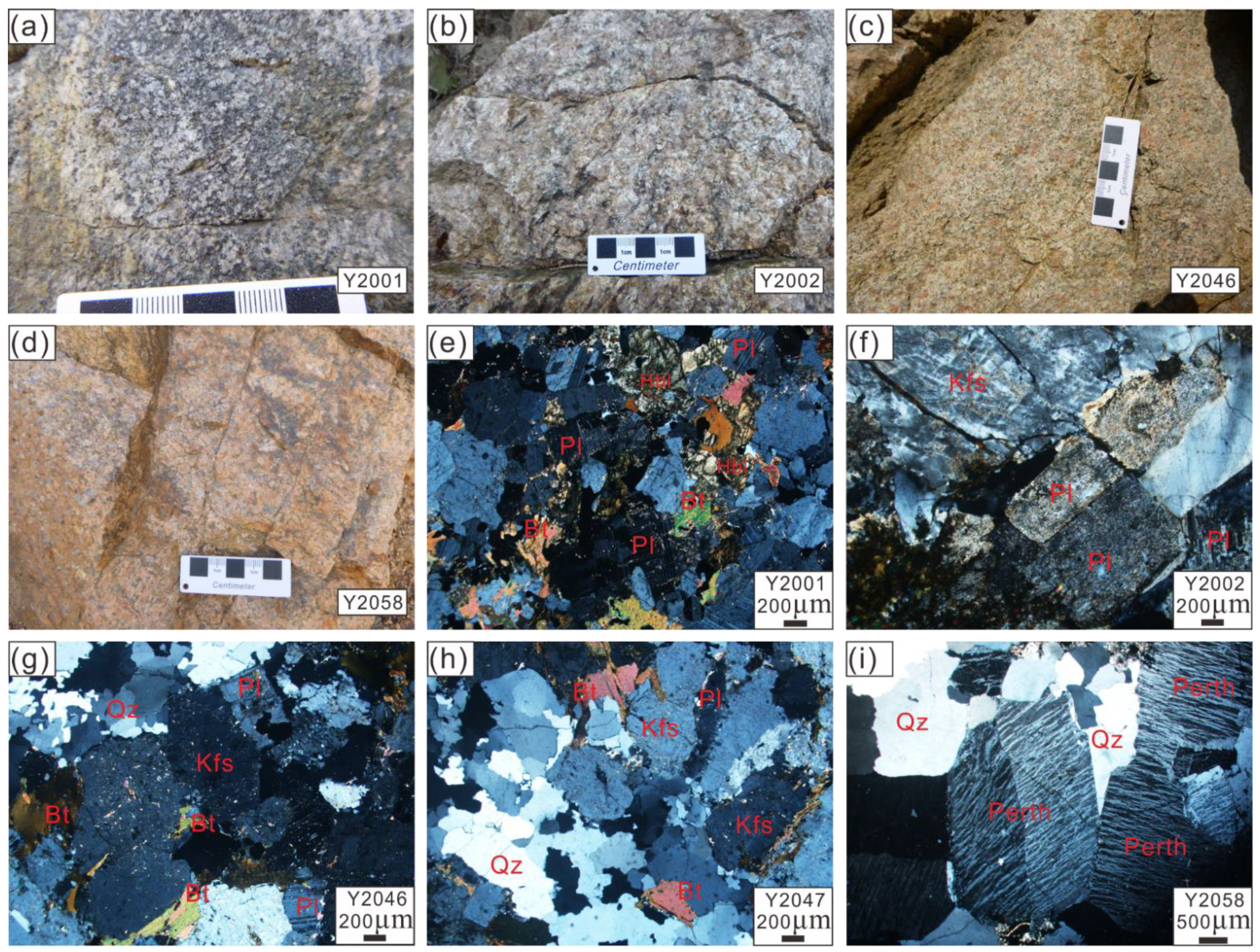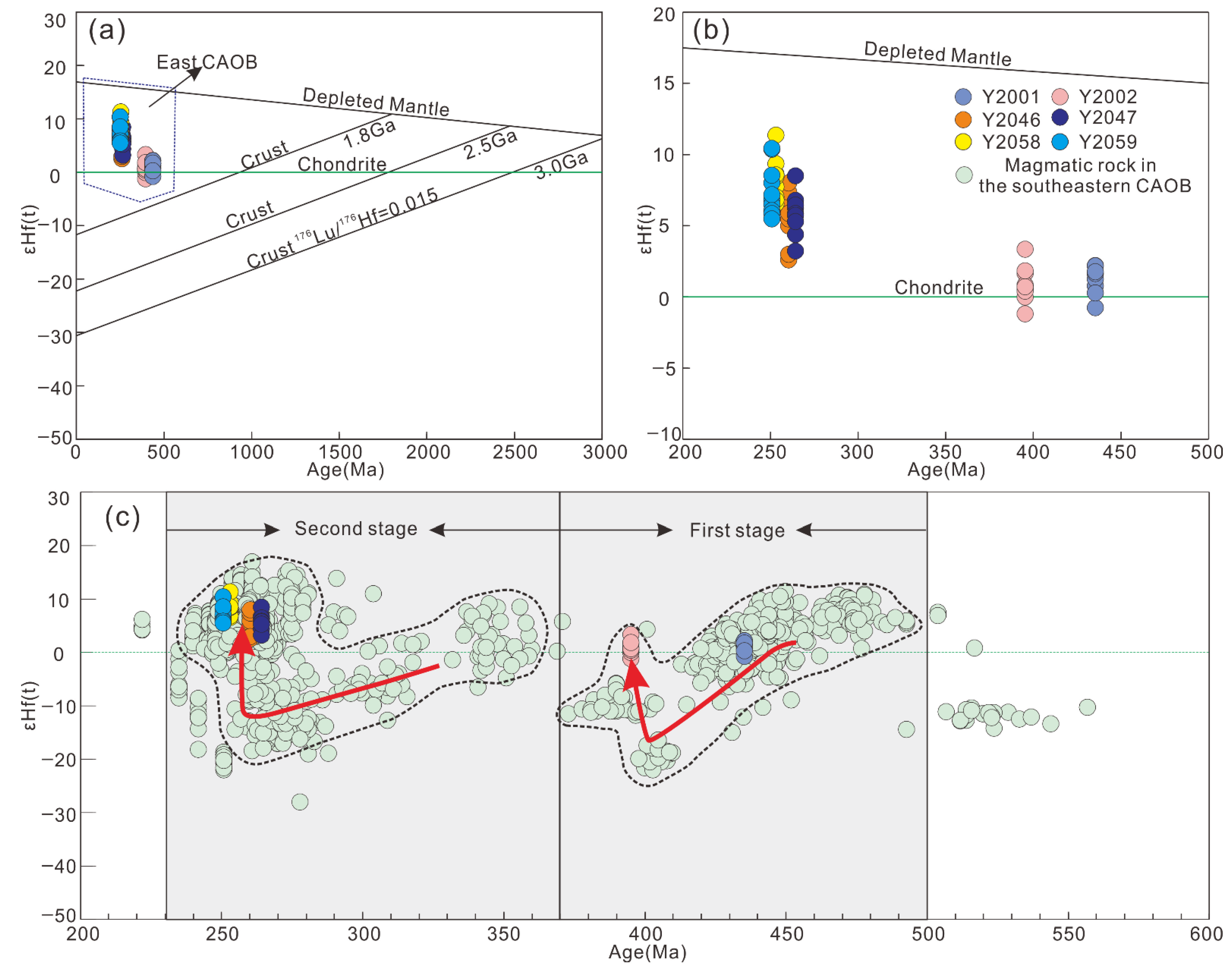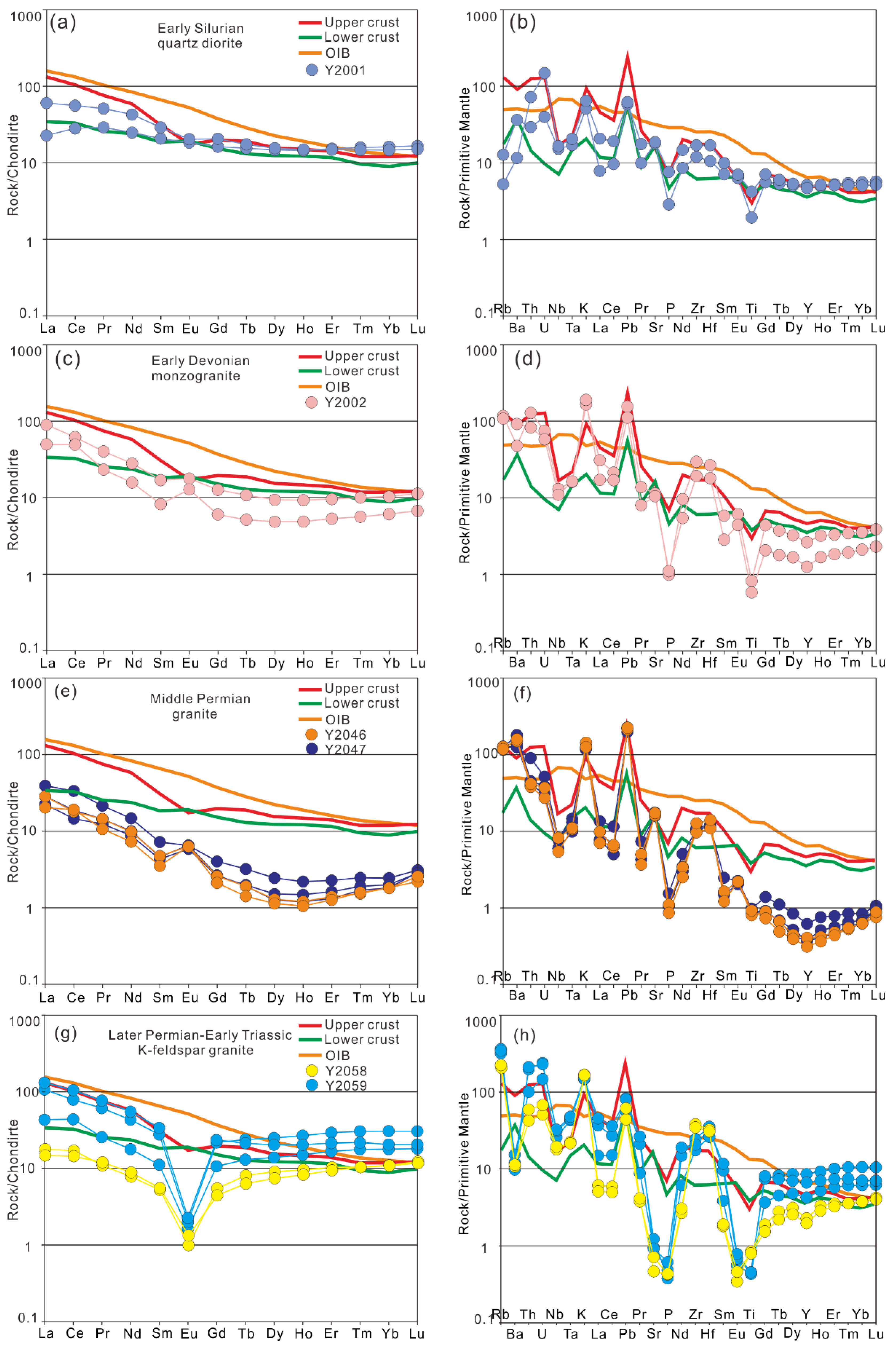Two-Stage Orogenic Cycle of the Eastern Paleo-Asian Ocean from Early Palaeozoic to Early Triassic: Constraints from Magmatic Rocks of the Southeastern Central Asian Orogenic Belt
Abstract
:1. Introduction
Geological Setting and Sample Descriptions
2. Analytical Methods
2.1. Zircon U-Pb Dating
2.2. Major and Trace Element Analyses
2.3. Zircon Hf Isotopic Analyses
3. Analytical Results
3.1. Zircon U-Pb Ages and Hf Isotopic Composition
3.2. Major and Trace Element Geochemistry
4. Discussion
4.1. Petrogenesis
4.1.1. Early Silurian Quartz Diorites
4.1.2. Early Devonian Monzogranites and Late Permian-Early Triassic Syenogranite
4.1.3. Middle Permian Granites
4.2. Tectonic Evolution and Implications
4.2.1. Tectonic Evolution
4.2.2. Tectonic Implications
5. Conclusions
- (1)
- We have identified four periods of magmatism in the southeastern Central Asian Orogenic Belt, namely Early Silurian quartz diorites (434.7 Ma), Early Devonian monzogranites (394.2 Ma), Middle Permian granites (260.2–264.5 Ma) and Late Permian-Early Triassic syenogranite (250.8–253.6 Ma).
- (2)
- The quartz diorites originated from partial melting of mafic lower crust with minor, if any, mantle contribution. The monzogranites were derived from the crust modified by mantle-derived fluids or melts. The granites are adakitic in composition and originated from juvenile thickened lower crust. The syenogranites were derived from juvenile crust that formed by partial melting of depleted mantle. The quartz diorites and granites were formed in a subduction setting, and the monzogranites and syenogranite were formed in an extensional setting.
- (3)
- The subduction of the eastern PAO can be divided into two stages. The first stage is the evolution of the Bainaimiao ocean from the Late Cambrian to the Early Devonian and the second stage is the final closure evolution from the Early Permian to the Triassic. The final closure time is Late Permian (~254 Ma).
Supplementary Materials
Author Contributions
Funding
Institutional Review Board Statement
Informed Consent Statement
Data Availability Statement
Acknowledgments
Conflicts of Interest
References
- Wilson, J.T. Did the Atlantic close and then re-open? Nature 1966, 211, 676–681. [Google Scholar] [CrossRef]
- Li, S.Z.; Yang, Z.; Zhao, S.J.; Li, X.Y.; Guo, L.L.; Yu, S.; Liu, X.; Suo, Y.H.; Li, H.Y. Global Early Paleozoic Orogens (Ⅰ): Collision-Type Orogeny. J. Jilin Univ. (Earth Sci. Ed.) 2016, 46, 945–967, (In Chinese with English Abstract). [Google Scholar]
- Li, S.Z.; Yang, Z.; Zhao, S.J.; Li, X.Y.; Suo, Y.H.; Guo, L.L.; Yu, S.; Dai, L.M.; Li, S.J.; Mou, D.L. Global Early Paleozoic Orogens (Ⅱ): Subduction-Accretionary-Type Orogen. J. Jilin Univ. (Earth Sci. Ed.) 2016, 46, 968–1004, (In Chinese with English abstract). [Google Scholar]
- Li, S.Z.; Li, X.Y.; Zhao, S.J.; Yang, Z.; Liu, X.; Guo, L.L.; Wang, Y.M.; Hao, Y.; Zhang, J.; Hu, M.Y. Global Early Paleozoic Orogens (Ⅲ): Intracontinental Orogen in South China. J. Jilin Univ. (Earth Sci. Ed.) 2016, 46, 1005–1025, (In Chinese with English Abstract). [Google Scholar]
- Cawood, P.A.; Kröner, A.; Collins, W.J.; Kusky, T.M.; Mooney, W.D.; Windley, B.F. Accretionary orogens through Earth history. Geol. Soc. Spec. Publ. 2009, 318, 11–36. [Google Scholar] [CrossRef]
- Groves, D.I.; Bierlein, F.P. Geodynamic settings of mineral deposit systems. J. Geol. Soc. Lond. 2007, 164, 19–30. [Google Scholar] [CrossRef]
- Sengör, A.M.C.; Natal’In, B.A.; Burtman, V.S. Evolution of the Altaid tectonic collage and Palaeozoic crustal growth in Eurasia. Nature 1993, 364, 299–307. [Google Scholar] [CrossRef]
- Xiao, W.; Windley, B.F.; Han, C.; Liu, W.; Wan, B.; Zhang, J.; Ao, S.; Zhang, Z.; Song, D. Late Paleozoic to early Triassic multiple roll-back and oroclinal bending of the Mongolia collage in Central Asia. Earth Sci. Rev. 2017, 186, 94–128. [Google Scholar] [CrossRef]
- Zhou, J.B.; Cao, J.L.; Wilde, S.A.; Zhao, G.C.; Zhang, J.J.; Wang, B. Paleo-Pacific subduction-accretion: Evidence from Geochemical and U-Pb zircon dating of the Nadanhada accretionary complex, NE China. Tectonics 2014, 33, 2444–2466. [Google Scholar] [CrossRef]
- Wu, F.Y.; Sun, D.Y.; Ge, W.C.; Zhang, Y.B.; Grant, M.L.; Wilde, S.A.; Jahn, B.M. Geochronology of the Phanerozoic granitoids in northeastern China. J. Asian Earth Sci. 2011, 41, 1–30. [Google Scholar] [CrossRef]
- Khain, E.V.; Bibikova, E.V.; Salnikova, E.B.; Kröner, A.; Gibsher, A.S.; Didenko, A.N.; Degtyarev, K.E.; Fedotova, A.A. The Paleo–Asian Ocean in the Neoproterozoic and early Paleozoic: New geochronologic data and Paleotectonic reconstructions. Precambrian Res. 2003, 122, 329–358. [Google Scholar] [CrossRef]
- Zhang, S.H.; Zhao, Y.; Ye, H.; Liu, J.M.; Hu, Z.C. Origin, and evolution of the Bainaimiao arc belt: Implications for crustal growth in the southern Central Asian orogenic belt. Bull. Geol. Soc. Am. 2014, 126, 1275–1300. [Google Scholar] [CrossRef]
- Jian, P.; Liu, D.; Kröner, A.; Windley, B.F.; Shi, Y.; Zhang, F.; Shi, G.; Miao, L.; Zhang, W.; Zhang, Q.; et al. Time scale of an early to mid-Paleozoic orogenic cycle of the long-lived Central Asian Orogenic Belt, Inner Mongolia of China: Implications for continental growth. Lithos 2008, 101, 233–259. [Google Scholar] [CrossRef]
- Xiao, W.; Windley, B.F.; Hao, J.; Zhai, M. Accretion leading to collision and the Permian Solonker suture, Inner Mongolia, China: Termination of the central Asian orogenic belt. Tectonics 2003, 22, 1484–1505. [Google Scholar] [CrossRef]
- Han, Y.G.; Zhao, G.; Cawood, P.A.; Sun, M.; Eizenhöfer, P.R.; Hou, W.; Zhang, X.; Liu, Q. Tarim and North China cratons linked to northern Gondwana through switching accretionary tectonics and collisional orogenesis. Geology 2016, 44, 95–98. [Google Scholar] [CrossRef]
- Han, Y.G.; Zhao, G.; Sun, M.; Eizenhöfer, P.R.; Hou, W.; Zhang, X.; Liu, Q.; Wang, B.; Liu, D.; Xu, B. Late Paleozoic subduction, and collision processes during the amalgamation of the Central Asian Orogenic Belt along the South Tianshan suture zone. Lithos 2016, 246–247, 1–12. [Google Scholar] [CrossRef]
- The Paleozoic Tectonic Evolution of The west Segment of the Northern Margin of the North China Craton: Implicationfrom the Magmatic Evidence of Damao Region. Ph.D. Thesis, Northwest University, Xi’an, China, 2019. (In Chinese).
- Liu, C.; Zhao, G.; Liu, F.; Shi, J. Detrital zircon U-Pb and Hf isotopic and whole-rock geochemical study of the Bayan Obo Group, northern margin of the North China Craton: Implications for Rodinia reconstruction. Precambrian Res. 2017, 303, 372–391. [Google Scholar] [CrossRef]
- Shi, Y.; Liu, D.; Miao, L.; Zhang, F.; Jian, P.; Zhang, W.; Hou, K.; Xu, J. Devonian A-type granitic magmatism on the northern margin of the North China Craton: SHRIMP U-Pb zircon dating and Hf-isotopes of the Hongshan granite at Chifeng, Inner Mongolia, China. Gondwana Res. 2010, 17, 632–641. [Google Scholar] [CrossRef]
- Xu, B.; Charvet, J.; Chen, Y.; Zhao, P.; Shi, G. Middle Paleozoic convergent orogenic belts in western Inner Mongolia (China): Framework, kinematics, geochronology, and implications for tectonic evolution of the Central Asian Orogenic Belt. Gondwana Res. 2013, 23, 1342–1364. [Google Scholar] [CrossRef]
- Zhang, Y.P.; Su, Y.Z.; Li, J.C. Regional tectonics significance of the Late Silurian Xibiehe Formation in central Inner Mongolia, China. Geol. Bull. China 2010, 29, 1599–1605. (In Chinese) [Google Scholar]
- Jing, Y.; Ge, W.; Dong, Y.; Yang, H.; Ji, Z.; Bi, J.; Zhou, H.; Xing, D. Early Middle Permian southward subduction of the eastern Paleo-Asian Ocean: Constraints from geochronology and geochemistry of intermediate-acidic volcanic rocks in the northern margin of the North China Craton. Lithos 2020, 364–365, 10549. [Google Scholar] [CrossRef]
- Jing, Y.; Ji, Z.; Ge, W.C.; Dong, Y.; Yang, H.; Bi, J.H. Middle–late Permian I-type granitoids from the Diaobingshan region in the northern margin of the North China Craton: Insight into southward subduction of the Paleo–Asian Ocean. Int. Geol. Rev. 2020, 63, 357–379. [Google Scholar] [CrossRef]
- Jing, Y.; Yang, H.; Ge, W.; Dong, Y.; Ji, Z.; Bi, J.; Zhou, H.; Xing, D. When did the final closure occur of the eastern Paleo-Asian Ocean: Constraints from the latest Early–Middle Triassic adakitic granites in the southeastern Central Asian Orogenic Belt? Gondwana Res. 2022, 103, 146–171. [Google Scholar] [CrossRef]
- Chen, H.C.; Zhao, G.; Jahn, B.M.; Zhou, H.; Sun, M. Geochemistry, and geochronology of the Delinggou intrusion: Implications for the subduction of the paleo-Asian ocean beneath the north China craton. Gondwana Res. 2017, 43, 178–192. [Google Scholar] [CrossRef]
- Ge, W.C.; Wu, F.Y.; Zhou, C.Y.; Abdel Rahman, A.A. Emplacement age of the Tahe granite and its constraints on the tectonic nature of the Erguna block in the northern part of the Da Xing’an Range. Chin. Sci. Bull. 2005, 50, 2097–2105. [Google Scholar] [CrossRef]
- Ge, W.C.; Wu, F.Y.; Zhou, C.Y.; Zhang, J.H. Porphyry Cu–Mo deposits in the Eastern Xing’an–Mongolian orogenic belt: Mineralization ages and their geodynamic implications. Chin. Sci. Bull. 2007, 52, 3416–3427. [Google Scholar] [CrossRef]
- Zhao, P.; Appel, E.; Xu, B.; Sukhbaatar, T. First Paleomagnetic Result from the Early Permian Volcanic Rocks in Northeastern Mongolia: Evolutional Implication for the Paleo-Asian Ocean and the Mongol-Okhotsk Ocean. J. Geophys. Res. Solid Earth 2020, 125, e2019JB017338. [Google Scholar] [CrossRef]
- Zhao, P.; Chen, Y.; Xu, B.; Faure, M.; Shi, G.; Choulet, F. Did the Paleo-Asian Ocean between North China Block and Mongolia Block exist during the late Paleozoic? First paleomagnetic evidence from central-eastern Inner Mongolia, China. J. Geophys. Res. Solid Earth 2013, 118, 1873–1894. [Google Scholar] [CrossRef]
- Cao, H.H.; Xu, W.L.; Pei, F.P.; Wang, Z.W.; Wang, F.; Wang, Z.J. Zircon u–pb geochronology and petrogenesis of the late Paleozoic–early Mesozoic intrusive rocks in the eastern segment of the northern margin of the north China block. Lithos 2013, 170–171, 191–207. [Google Scholar] [CrossRef]
- Pei, F.P.; Zhang, Y.; Wang, Z.W.; Cao, H.H.; Xu, W.L.; Wang, Z.J.; Wang, F.; Yang, C. Early–Middle Paleozoic subduction–collision history of the south-eastern Central Asian Orogenic Belt: Evidence from igneous and metasedimentary rocks of central Jilin Province, NE China. Lithos 2016, 261, 164–180. [Google Scholar] [CrossRef]
- Gu, C.; Zhu, G.; Li, Y.; Su, N.; Xiao, S.; Zhang, S.; Liu, C. Timing of deformation and location of the eastern Liaoyuan Terrane, NE China: Constraints on the final closure time of the Paleo-Asian Ocean. Gondwana Res. 2018, 60, 194–212. [Google Scholar] [CrossRef]
- Zheng, C.Z. New partition of Devonian strata in Jilin Province. J. Stratigr. 1989, 13, 47–51. (In Chinese) [Google Scholar]
- Guo, W.X.; Yin, C.J.; Wang, Y.S. Description of Geological Map of Changchun City; Jilin Geological Survey Institute: Changchun, China, 2001. (In Chinese) [Google Scholar]
- Wang, Z.J.; Xu, W.L.; Pei, F.P.; Wang, Z.W.; Li, Y. Geochronology, and provenance of detrital zircons from late Paleozoic strata of central Jilin Province, Northeast China: Implications for the tectonic evolution of the eastern Central Asian Orogenic Belt. Int. Geol. Rev. 2015, 25, 211–228. [Google Scholar] [CrossRef]
- Wang, Z.J.; Xu, W.L.; Pei, F.P.; Wang, Z.W.; Li, Y.; Cao, H.H. Geochronology, and geochemistry of middle Permian-Middle Triassic intrusive rocks from central-eastern Jilin Province, NE China: Constraints on the tectonic evolution of the eastern segment of the Paleo-Asian Ocean. Lithos 2015, 238, 23–25. [Google Scholar] [CrossRef]
- Chen, Y.J.; Peng, Y.J.; Liu, Y.W.; Sun, G. Dismemberment of Bailazi Formation of the Qinghezhen Group. J. Jilin Univ. (Earth Sci. Ed.) 2006, 36, 24–31, (In Chinese with English Abstract). [Google Scholar]
- Liu, Y.S.; Hu, Z.C.; Gao, S.; Günther, D.; Xu, J.; Gao, C.G.; Chen, H.H. In situ analysis of major and trace elements of anhydrous minerals by LA-ICP-MS without applying an internal standard. Chem. Geol. 2008, 257, 34–43. [Google Scholar] [CrossRef]
- Ludwig, K.R. User’s Manual for Isoplot 3.00, a Geochronological Toolkit for Microsoft Excel; Berkeley Geochronology Center: Berkeley, CA, USA, 2003; no.4. Components. [Google Scholar]
- Anderson, T. Correction of common lead in U–Pb analyses that do not report 204Pb. Chem. Geol. 2002, 192, 59–79. [Google Scholar] [CrossRef]
- Wu, F.Y.; Yang, Y.H.; Xie, L.W.; Yang, J.H.; Xu, P. Hf isotopic compositions of the standard zircons and baddeleyites used in U-Pb geochronology. Chem. Geol. 2006, 234, 105–126. [Google Scholar] [CrossRef]
- Guo, C.; Chen, Y.; Zeng, Z.; Lou, F. Petrogenesis of the Xihuashan granites in southeastern China: Constraints from geochemistry and in-situ analyses of zircon U-Pb-Hf-O isotopes. Lithos 2012, 148, 209–227. [Google Scholar] [CrossRef]
- Hoskin, P.W.O.; Schaltegger, U. The composition of zircon and igneous and metamorphic petrogenesis. Rev. Mineral. Geochem. 2003, 53, 27–62. [Google Scholar] [CrossRef]
- Zindler, A. Chemical Geodynamics. Annu. Rev. Earth Planet. Sci. 1986, 14, 493–571. [Google Scholar] [CrossRef]
- Cao, H.H.; Xu, W.L.; Pei, F.P.; Guo, P.Y.; Wang, F. Permian tectonic evolution of the eastern section of the northern margin of the North China Plate: Constraints from zircon U-Pb geochronology and geochemistry of the volcanic rocks. Acta Petrol. Sin. 2012, 28, 2733–2750, (In Chinese with English Abstract). [Google Scholar]
- Le Maitre, R.W. Igneous rocks—A classification and glossary of terms. Recommendations of the IUGS Subcommission on the Systematics of Igneous Rocks, 2nd ed.; Cambridge University Press: Cambridge, UK, 2002. [Google Scholar]
- Wu, D.Q.; Sun, F.Y.; Pan, Z.C.; Tian, N. Geochronology, Geochemistry, and Hf Isotopic Compositions of Triassic Igneous Rocks in the Easternmost Segment of the East Kunlun Orogenic Belt, NW China: Implications for Magmatism and Tectonic Evolution. Int. Geol. Rev. 2020, 63, 1011–1029. [Google Scholar] [CrossRef]
- Boynton, W.V. Geochemistry of the rare earth elements: Meteorite studies. In Rare Earth Element Geochemistry; Henderson, P., Ed.; Elsevier: Amsterdam, The Netherlands, 1984; pp. 63–114. [Google Scholar]
- Sun, S.S.; McDonough, W.F. Chemical, and isotopic systematics of oceanic basalts: Implications for mantle composition and processes. Geol. Soc. Spec. Publ. 1989, 42, 313–345. [Google Scholar] [CrossRef]
- Rudnick, R.L.; Gao, S. Composition of the Continental Crust. In Treatise on Geochemistry, 2nd ed.; Elsevier Science: Amsterdam, The Netherlands, 2003. [Google Scholar] [CrossRef]
- Frey, F.A.; Prinz, M. Ultramafic inclusions from San Carlos, Arizona: Petrologicand geochemical data bearing on their petrogenesis. Earth Planet. Sci. Lett. 1978, 38, 129–176. [Google Scholar] [CrossRef]
- Taylor, S.R.; Mclennan, S.M. The continental crust: Its composition and evolution. J. Geol. 1985, 94, 57–72. [Google Scholar]
- Hofmann, A.W.; Jochum, K.P.; Seufert, M.; White, W.M. Nb and Pb in oceanic basalts: New constraints on mantle evolution. Earth Planet. Sci. Lett. 1986, 79, 33–45. [Google Scholar] [CrossRef]
- Chappell, B.W.; White, A.J.R. Two contrasting granite types: 25 years later. Aust. J. Earth Sci. 2001, 48, 489–499. [Google Scholar] [CrossRef]
- Whalen, J.B.; Currie, K.L.; Chappell, B.W. A-type granites: Geochemical characteristics, discrimination and petrogenesis. Contrib. Mineral. Petrol. 1987, 95, 407–419. [Google Scholar] [CrossRef]
- Barbarin, B. A review of the relationships between granitoid types, their origins, and their geodynamic environments. Lithos 1999, 46, 605–626. [Google Scholar] [CrossRef]
- Watson, E.B.; Harrison, T.M. Zircon saturation revisited: Temperature and composition effects in a variety of crustal magma types. Earth Planet. Sci. Lett. 1983, 64, 295–304. [Google Scholar] [CrossRef]
- Eby, G.N. The A-type granitoids: A review of their occurrence and chemical characteristics and speculations on their petrogenesis. Lithos 1990, 26, 115–134. [Google Scholar] [CrossRef]
- Eby, G.N. Chemical subdivision of the A-type granitoids: Petrogenetic and tectonic implications. Geology 1992, 20, 641–644. [Google Scholar] [CrossRef]
- Skjerlie, K.P.; Johnston, A.D. Vapor-absent melting at 10 kbar of a biotite- and amphibole-bearing tonalitic gneiss: Implications for the generation of A-type granites. Geology 1992, 20, 263–266. [Google Scholar] [CrossRef]
- Xin, W.; Sun, F.Y.; Li, L.; Yan, J.M.; Zhang, Y.T.; Wang, Y.C.; Shen, T.S.; Yang, Y.J. The Wulonggou Metaluminous A2-Type Granites in the Eastern Kunlun Orogenic Belt, NW China: Rejuvenation of Subduction-Related Felsic Crust and Implications for Post-Collision Extension. Lithos 2018, 312–313, 108–127. [Google Scholar] [CrossRef]
- Defant, M.J.; Drummond, M.S. Derivation of some modern arc magmas by melting of young, subducted lithosphere. Nature 1990, 347, 662–665. [Google Scholar] [CrossRef]
- Defant, M.J.; Xu, J.F.; Kepezhinskas, P.; Wang, Q.; Zhang, Q.; Xiao, L. Adakites: Some variations on a theme. Acta Petrol. Sin. 2002, 18, 129–142. [Google Scholar]
- Martin, H. Adakitic magmas: Modern analogues of Archaean granitoids. Lithos 1999, 46, 411–429. [Google Scholar] [CrossRef]
- Wang, Q.; Wyman, D.A.; Xu, J.; Jian, P.; Zhao, Z.; Li, C.; Xu, W.; Ma, J.; He, B. Early Cretaceous adakitic granites in the Northern Dabie Complex, central China: Implications for partial melting and delamination of thickened lower crust. Geochim. Cosmochim. Acta 2007, 71, 2609–2636. [Google Scholar] [CrossRef]
- Gao, S.; Rudnick, R.L.; Yuan, H.L.; Liu, X.M.; Liu, Y.S.; Xu, W.L.; Ling, W.L.; Ayers, J.; Wang, X.C.; Wang, Q.H. Recycling lower continental crust in the North China craton. Nature 2004, 432, 892–897. [Google Scholar] [CrossRef]
- Hou, Z.Q.; Gao, Y.F.; Qu, X.M.; Rui, Z.Y.; Mo, X.X. Origin of adakitic intrusives generated during mid-Miocene east-west extension in southern Tibet. Earth Planet. Sci. Lett. 2004, 220, 139–155. [Google Scholar] [CrossRef]
- Atherton, M.P.; Petford, N. Generation of sodium-rich magmas from newly underplated basaltic crust. Nature 1993, 36, 144–146. [Google Scholar] [CrossRef]
- Wang, Q.; McDermott, F.; Xu, J.F.; Bellon, H.; Zhu, Y.T. Cenozoic K-rich adakitic volcanic rocks in the Hohxil area, northern Tibet: Lower-crustal melting in an intracontinental setting. Geology 2005, 33, 465–468. [Google Scholar] [CrossRef]
- Castillo, P.R.; Janney, P.E.; Solidum, R.U. Petrology and geochemistry of Camiguin Island, southern Philippines: Insights to the source of adakites and other lavas in a complex arc setting. Contrib. Mineral. Petrol. 1999, 134, 33–51. [Google Scholar] [CrossRef]
- Wareham, C.D.; Millar, L.L.; Vaughan, A.P.M. The generation of sodic granite magmas, western Palmer Land, Antarctic Peninsula. Contrib. Mineral. Petrol. 1997, 128, 81–96. [Google Scholar] [CrossRef]
- Stern, C.R.; Kilian, R. Role of the subducted slab, mantle wedge and continental crust in the generation of adakites from the Andean Austral Volcanic Zone. Contrib. Mineral. Petrol. 1996, 123, 263–281. [Google Scholar] [CrossRef]
- Xu, H.; Ma, C.; Zhang, J. Generation of Early Cretaceous High-Mg adakitic host and enclaves by magma mixing, Dabie Orogen, Eastern China. Lithos 2012, 142–143, 182–200. [Google Scholar] [CrossRef]
- Pearce, J.A.; Harris, N.B.W.; Tindle, A.G. Trace element discrimination diagrams for the tectonic interpretation of granitic rocks. J. Petrol. 1984, 25, 956–983. [Google Scholar] [CrossRef]
- Wu, F.Y.; Tang, J.H.; Liu, X.M. Geochronological Framework of the Mesozoic Granitic Magmatism in the Liaodong Peninsula, Northeast China. Geol. J. China Univ. 2005, 11, 305–317. (In Chinese) [Google Scholar]
- Peng, Y.J.; Qi, C.D.; Zhou, X.D.; Lu, X.B.; Dong, H.C.; Li, Z. Transition from Paleo-Asian Ocean domain to circum-pacific ocean domain for the Ji–Hei composite orogenic belt: Time mark and relationship to global tectonics. Geol. Resour. 2012, 21, 261–265, (in Chinese with English abstract). [Google Scholar]
- Yu, Q.; Ge, W.C.; Yang, H.; Zhao, G.C.; Zhang, Y.L.; Su, L. Petrogenesis of late Paleozoic volcanic rocks from the Daheshen Formation in central Jilin Province, NE China, and its tectonic implications: Constraints from geochronology, geochemistry and Sr-Nd-Hf isotopes. Lithos 2014, 192–195, 116–131. [Google Scholar] [CrossRef]
- Zhao, J.; Peng, Y.J.; Ding, M.G.; Liu, D.Y.; Zhang, N.; Yang, C. Late Hercynian–early indosinian magmatic cycles in Meihekou–Kaiyuan between Jilin and Liaoning provinces: Tectonic implication. Geol. Resour. 2012, 21, 371–375, (In Chinese with English Abstract). [Google Scholar]
- Wu, F.Y.; Zhao, G.C.; Sun, D.Y.; Wilde, S.A.; Yang, J.H. The Hulan Group: Its role in the evolution of the Central Asian Orogenic Belt of NE China. J. Asian Earth Sci. 2007, 30, 542–556. [Google Scholar] [CrossRef]
- Feng, G.Y.; Liu, S.; Zhong, H.; Jia, D.C.; Qi, Y.Q.; Wang, T.; Yang, Y.H. Geochemical characteristics and petrogenesis of late Paleozoic mafic rocks from Yumuchuan, Jilin Province. Geochimica 2010, 39, 427–438, (In Chinese with English Abstract). [Google Scholar]
- Chen, Q.; Qiu, G.L.; Xue, L.F.; Zou, X.M.; Zhou, H.P.; Du, Y.S. Palaeoplate evolution in the southern part of the Inner Mongolian Orogenic belt. Geol. Rev. 1993, 39, 477–483, (In Chinese with English Abstract). [Google Scholar]
- Ma, S.X.; Wang, Z.Q.; Zhang, Y.L.; Sun, J.X. Bainaimiao Arc as an Exotic Terrane Along the Northern Margin of the North China Craton: Evidences from Petrography, Zircon U-Pb Dating, and Geochemistry of the Early Devonian Deposits. Tectonics 2019, 38, 2606–2624. [Google Scholar] [CrossRef]
- Shang, H.S.; Tao, J.X.; Bao, Y.W.L.J.; Hao, X.Y. The arc–basin system and tectonic significance of early Paleozoic in Baiyunebo area, Inner Mongolia. Geol. Surv. Res. 2003, 26, 160–168, (In Chinese with English Abstract). [Google Scholar]
- Shao, J.A. The early Paleozoic ophiolite in central Nei Mongol and its significance in revealing the evolution history of the crust. In Contributions to the Project of Plate Tectonics in Northern China; Tang, K.D., Ed.; Geological Publishing House: Beijing, China, 1986; Volume 1, pp. 158–172. [Google Scholar]
- Tian, Y.J.; Xu, B.; Zhang, Y.J.; Yang, Z.N.; Yao, Z.W. Sedimentary Facies and Provenance Area Analysis of Xuniwusu Formation in Tugurige Area, Southern Xing-Meng Orogenic Belt and Their Tectonic Significance. Acta Sci. Nat. Univ. Pekin. 2019, 55, 1038–1054. [Google Scholar] [CrossRef]
- Zhang, J.F.; Liu, Z.H.; Guan, Q.B.; Xu, Z.Y.; Wang, X.A.; Zhu, K. Age, and geological significance of Xuniwusu Formation from Bainaimiao area of Sonid Youqi, Inner Mongolia. Acta Petrol. Sin. 2017, 33, 3147–3160. [Google Scholar]
- Fu, C.L.; Sun, D.Y.; Zhang, X.Z.; Wei, H.Y.; Gou, J. Discovery and geological significance of the Triassic high–Mg diorites in Hunchu area. Jilin Province. Acta Petrol. Sin. 2010, 26, 1089–1102, (In Chinese with English abstract). [Google Scholar]
- Yuan, L.L.; Zhang, X.H.; Xue, F.H.; Lu, Y.H.; Zong, K.Q. Late Permian High-Mg andesite and basalt association from northern Liaoning, North China: Insights into the final closure of the Paleo-Asian Ocean and the orogen-craton boundary. Lithos 2016, 258, 58–76. [Google Scholar] [CrossRef]














Publisher’s Note: MDPI stays neutral with regard to jurisdictional claims in published maps and institutional affiliations. |
© 2022 by the authors. Licensee MDPI, Basel, Switzerland. This article is an open access article distributed under the terms and conditions of the Creative Commons Attribution (CC BY) license (https://creativecommons.org/licenses/by/4.0/).
Share and Cite
Sun, J.; Qian, Y.; Li, J.; Shen, Y.; Zhao, L.; Sun, F. Two-Stage Orogenic Cycle of the Eastern Paleo-Asian Ocean from Early Palaeozoic to Early Triassic: Constraints from Magmatic Rocks of the Southeastern Central Asian Orogenic Belt. Minerals 2022, 12, 1040. https://doi.org/10.3390/min12081040
Sun J, Qian Y, Li J, Shen Y, Zhao L, Sun F. Two-Stage Orogenic Cycle of the Eastern Paleo-Asian Ocean from Early Palaeozoic to Early Triassic: Constraints from Magmatic Rocks of the Southeastern Central Asian Orogenic Belt. Minerals. 2022; 12(8):1040. https://doi.org/10.3390/min12081040
Chicago/Turabian StyleSun, Jinlei, Ye Qian, Jinyu Li, Yanjie Shen, Lixiang Zhao, and Fegnyue Sun. 2022. "Two-Stage Orogenic Cycle of the Eastern Paleo-Asian Ocean from Early Palaeozoic to Early Triassic: Constraints from Magmatic Rocks of the Southeastern Central Asian Orogenic Belt" Minerals 12, no. 8: 1040. https://doi.org/10.3390/min12081040
APA StyleSun, J., Qian, Y., Li, J., Shen, Y., Zhao, L., & Sun, F. (2022). Two-Stage Orogenic Cycle of the Eastern Paleo-Asian Ocean from Early Palaeozoic to Early Triassic: Constraints from Magmatic Rocks of the Southeastern Central Asian Orogenic Belt. Minerals, 12(8), 1040. https://doi.org/10.3390/min12081040





